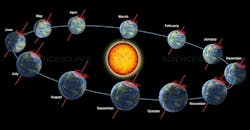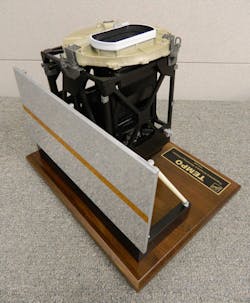Weather monitoring is about to begin from Earth’s orbit, with Ball Aerospace’s delivering of the Tropospheric Emissions: Monitoring of Pollution (TEMPO) spectrometer to NASA after a successful final acceptance review. The ultraviolet/visible-light, air-quality spectrometer will be launched into geostationary orbit over greater North America to study air quality and, hopefully, slow the pollution of air by spotting pollution sources from the sky.
“Ball Aerospace has more than 30 years of innovation in advanced spectrometers and expertise in producing cost-effective solutions for Earth observation and remote-sensing missions,” said Makenzie Lystrup, vice president and general manager, Civil Space, Ball Aerospace. “Data gathered from TEMPO will advance air quality research, helping to assess and forecast air pollution by identifying sources and distribution of pollutants in the atmosphere.”
The TEMPO spectrometer, fabricated by Ball Aerospace, will be placed in geostationary orbit over North America to continuously gather air-quality samples as part of studying causes of air pollution. (Courtesy of NASA)
TEMPO will provide hourly daylight measurements of ozone, nitrogen dioxide, and contaminants across North America, from coast to coast and from Mexico City to Canada. The highly accurate measurement system is expected to provide microliter volumes for much greater insight into air pollution and causes and how to prevent future air-quality deterioration. Ball Aerospace built the TEMPO system at the company’s Boulder, Co. facility in tandem with the Geostationary Environmental Monitoring Spectrometer (GEMS) to capture design efficiencies between the two instruments.
The TEMPO development team includes the Smithsonian Astrophysical Observatory; NASA’s Langley Research Center; NASA’s Goddard Space Flight Center; the U.S. Environmental Protection Agency (EPA); and several U.S. universities and research organizations.
About the Author
Jack Browne
Technical Contributor
Jack Browne, Technical Contributor, has worked in technical publishing for over 30 years. He managed the content and production of three technical journals while at the American Institute of Physics, including Medical Physics and the Journal of Vacuum Science & Technology. He has been a Publisher and Editor for Penton Media, started the firm’s Wireless Symposium & Exhibition trade show in 1993, and currently serves as Technical Contributor for that company's Microwaves & RF magazine. Browne, who holds a BS in Mathematics from City College of New York and BA degrees in English and Philosophy from Fordham University, is a member of the IEEE.


